Understanding Squirrel Cone Excluders: A Comprehensive Guide
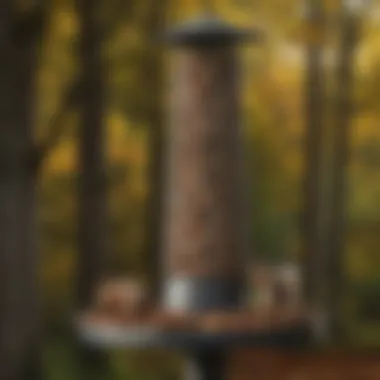
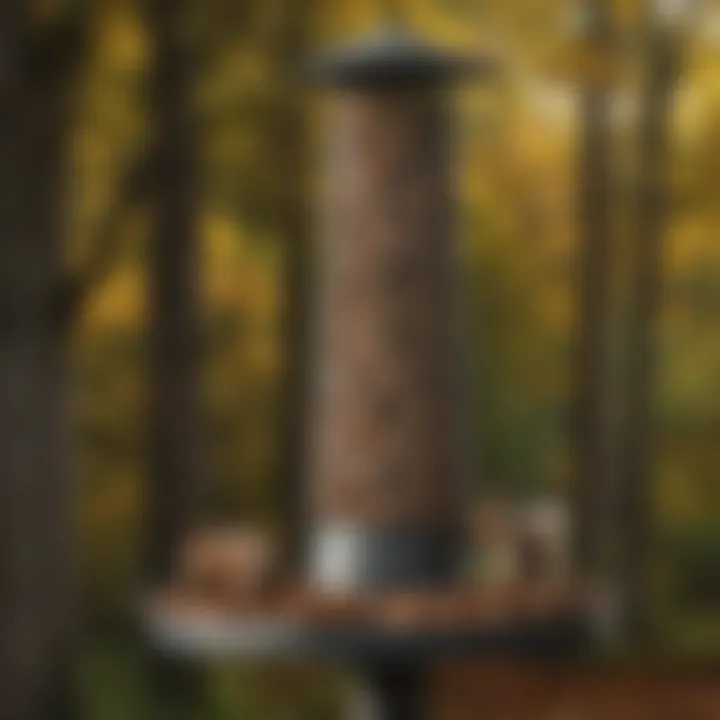
Intro
Squirrels, while often seen as charming and playful creatures, can become a nuisance for homeowners, particularly when it comes to bird feeders. These agile animals tend to raid feeders, consuming the precious seeds meant for your feathered friends. To combat this issue, many people turn to a specific solution known as squirrel cone excluders. This article serves as a comprehensive guide to understanding these devices, their effectiveness, and installation. We will also explore alternatives and address common concerns associated with their use.
Pest Identification
Squirrels are not the only pests that can invade your yard and bird feeders. It is essential to recognize the signs of a squirrel infestation, along with other common pest species.
Detailed descriptions of common pests
- Eastern Gray Squirrel
The Eastern gray squirrel is the most common species found in urban and suburban areas. These animals are known for their bushy tails and gray fur. - Fox Squirrel
Slightly larger than the Eastern gray squirrel, the fox squirrel has a more reddish-brown fur pattern. They often inhabit wooded areas and can be spotted in gardens as they forage for food. - Red Squirrel
This smaller and more aggressive species is less common in urban areas but can still pose a threat to bird feeders. They have a distinctive reddish fur and are agile climbers.
Signs and symptoms of infestations
- Damage to bird feeders: Look for chewed edges or seeds scattered on the ground beneath feeders.
- Scratching noises: These familiar sounds, especially in the early morning, can indicate active squirrel presence.
- Nesting materials: Gathering of twigs or leaves may suggest nearby squirrel nesting activities.
Understanding these pests and recognizing their signs can help homeowners take appropriate actions to mitigate any potential damage.
Prevention Strategies
Preventing squirrels from accessing bird feeders is crucial for maintaining a healthy environment for birds. Here are some effective strategies you can implement.
Home maintenance tips for pest prevention
- Secure bird feeders: Choose feeders designed with squirrel-proof technology. There are models available with weight-activated doors that close when squirrels attempt to access them.
- Location matters: Position feeders at least 6-8 feet away from trees or structures that squirrels can climb.
- Remove potential food sources: Ensure pets do not leave food outside. Also, clean up seed spills that may attract squirrels.
Natural deterrents and barriers
- Physical barriers: Consider installing squirrel cone excluders as an effective solution. These devices limit access to feeders without harming the animals.
- Using cinnamon or cayenne pepper: Sprinkling these around your bird feeders can create an unpleasant environment for squirrels, while remaining safe for birds.
Treatment Options
In addition to prevention, understanding treatment options can aid in managing any existing squirrel problems.
Overview of chemical vs. natural treatments
Using chemicals to deter animals can pose risks to non-target species, including birds. Hence, natural treatments are encouraged whenever possible. Natural options may include:
- Essential oils: Scents like peppermint can disrupt squirrel behavior.
- Live traps: These can be used for relocating squirrels far away from your property, ensuring they do not return.
Step-by-step guides for DIY treatments
For homeowners looking to address the issue without professional assistance, consider the following DIY method:
- Construct your own squirrel cone excluder:
Use lightweight materials, such as wire mesh, to create a funnel shape that directs squirrels away from feeders. This method is practical and simple. - Regular maintenance:
Inspect your bird feeders and any installations monthly to ensure effectiveness.
"Squirrel cone excluders provide a humane way to protect bird feeders while allowing you to enjoy the beauty of wildlife."
Prelims to Squirrel Cone Excluders
Squirrel cone excluders represent a unique solution tailored to mitigate conflicts between squirrels and those who desire to protect bird feeders and gardens. For many homeowners, witnessing squirrels raiding bird feeders can be frustrating. These agile animals often outsmart traditional feeding setups, leading to the depletion of food meant for birds. Understanding how these devices work holds significance for effectively managing wildlife interactions while also catering to the aesthetic appeal and functionality of outdoor spaces.
Definition and Purpose
A squirrel cone excluder is a device specifically designed to prevent squirrels from accessing bird feeders. Typically, this is a cone-shaped structure that attaches to the feeder's pole or hanger. The main purpose is to create a barrier that squirrels cannot navigate. Unlike other deterrents, which may only scare squirrels away temporarily, cone excluders provide a more permanent solution, allowing birds to feed without disturbance.
The use of squirrel cone excluders has gained traction due to increasing interest in wildlife conservation. By ensuring that bird feed remains available for the intended avian users, homeowners can assist in maintaining balanced ecosystems within their gardens.
Common Issues with Squirrels
The presence of squirrels comes with various challenges. Primarily, these creatures can consume birdseed at an alarming rate. A single visit from a squirrel can empty a feeder, diminishing the resources available for birds. Additionally, squirrels may damage feeders while attempting to access the food. This leads to unnecessary costs associated with repairs or replacements.
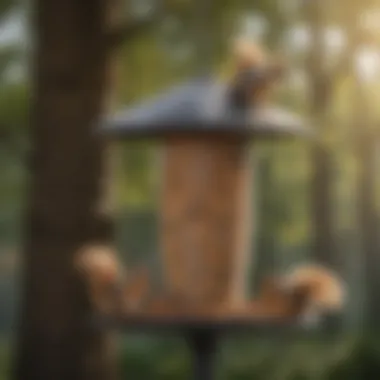
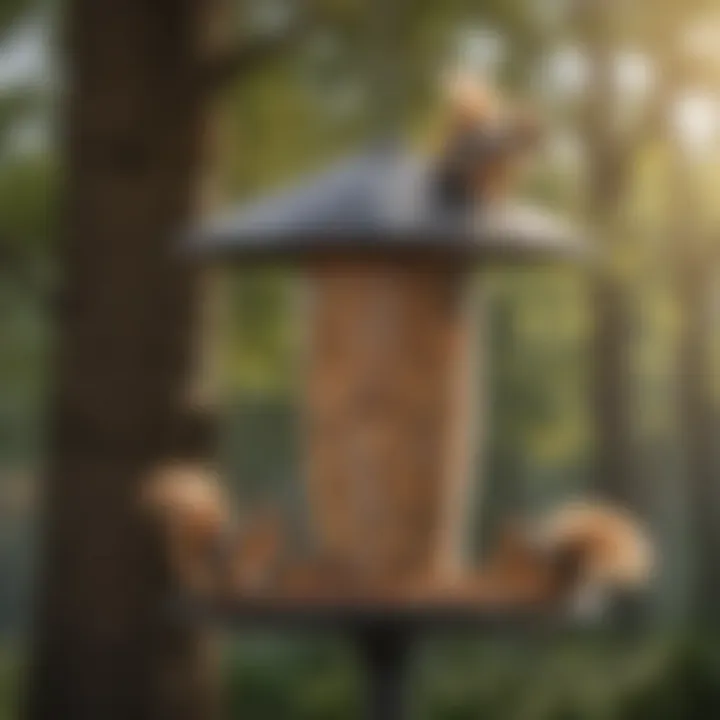
Squirrels are also known to invade vegetable gardens, uprooting seedlings or eating ripe produce. This behavior can prevent gardeners from enjoying their harvest. Therefore, finding an effective method to keep them at bay is essential.
In summary, understanding squirrel cone excluders, their definition, purpose, and the issues caused by squirrels fosters a better approach to wildlife management. It ultimately enhances the bird feeding experience, making it more rewarding for those who engage in it.
Mechanics of Squirrel Cone Excluders
Understanding the mechanics of squirrel cone excluders is crucial for those looking to protect their bird feeders from squirrels. These devices are engineered to allow birds to access food while keeping squirrels at bay. Grasping how they function and what materials are used provides insight not only into their effectiveness but also into how to properly install and maintain them. This knowledge is vital for ensuring long-term use and satisfaction.
How They Function
Squirrel cone excluders operate on a simple yet effective principle. They are typically designed to fit over or around a bird feeder. When a squirrel attempts to reach the food, the cone shape of the device causes the squirrel to slide down due to gravity. This slope makes it nearly impossible for the squirrel to gain a firm grip, unlike the more agile birds for whom the feeder was intended.
The design often includes various sizes of openings that are suited to birds while being less accessible to squirrels. Some models may have a rotating mechanism that further complicates a squirrel's efforts to access the feeder. This functionality not only protects the seed from being devoured by squirrels but also allows birds of various sizes to enjoy feeding in peace.
Materials Used
The materials chosen for constructing squirrel cone excluders play a significant role in their overall effectiveness and durability. Most commonly, manufacturers use a mix of metal and plastic.
- Metal: Metal parts may include steel or aluminum, providing strength that can withstand outdoor conditions. This resistance helps the device remain effective against not just squirrels but other animals as well.
- Plastic: Some parts are made from high-grade plastic, designed to be UV-resistant and weatherproof. This helps prolong the life of the device, preventing degradation over time from sun exposure and rain.
- Composite Materials: Blends of both metal and plastic may also be utilized. Such combinations can enhance both the durability and the aesthetic appeal of the product.
Choosing a squirrel cone excluder constructed from high-quality materials ensures that it remains functional throughout various seasons and environmental conditions.
"Investing in a durable squirrel cone excluder saves money in the long run, minimizing the costs of replacing damaged feeders."
Proper selection and installation of these devices can lead homeowners to a successful bird feeding experience without the hassle of unwelcome squirrel visits.
Advantages of Using Squirrel Cone Excluders
Using squirrel cone excluders has multiple benefits for homeowners who invest in protecting their bird feeders. These devices serve an essential function in avoiding food loss while ensuring that birdfeeders remain accessible to desired bird species.
Protecting Bird Feed
One of the primary advantages of squirrel cone excluders is their ability to protect bird feed. Squirrels, known for their agility and determination, can quickly empty bird feeders, leading to frustration for those who appreciate watching birds. When squirrel cone excluders are in place, they create a barrier that is difficult for squirrels to navigate, allowing only birds to access the food. This is particularly critical for bird enthusiasts who want to attract specific species.
By using these devices, you significantly decrease the amount of bird feed consumed by squirrels. This preservation of feed translates into reduced costs and less frequent refills. Additionally, it enables you to maintain a consistent feeding schedule, which benefits the birds' nutritional needs. In the end, more birds will visit your feeders, bringing vibrancy to your garden or yard.
Reducing Conflict with Wildlife
Another essential aspect of squirrel cone excluders is their ability to reduce conflict with wildlife. Squirrels often forage for food, and their presence can lead to competition with other wildlife and heightened tensions in your yard. The cone excluders help to minimize these interactions, making your outdoor space more harmonious.
When implemented effectively, these devices provide a means to manage the food supply without significantly disrupting the local wildlife. They create a safe environment where birds can feed freely, away from the persistent distractions caused by squirrels. Many homeowners report fewer disturbances at bird feeders, resulting in a more peaceful outdoor setting.
Furthermore, reduced competition impacts not only birds but also other creatures that might rely on the same food sources. A careful balance can be maintained, supporting various local species without favoring one over another. In this way, squirrel cone excluders contribute positively to wildlife management and biodiversity in your immediate environment.
"Squirrel cone excluders enable a thoughtful approach to managing bird feeders, providing protection for both feed and residents of the yard."
Overall, choosing to use squirrel cone excluders enhances the experience of feeding birds while also promoting a healthier, more sustainable interaction with local wildlife.
Installation Process
The installation process of squirrel cone excluders is crucial. Proper installation ensures effectiveness in keeping squirrels away from bird feeders. If wrongly installed, these devices might not work as intended, leading to frustration for users. Understanding the installation steps can help prevent common pitfalls that may occur. This section will outline what needs to be prepared and provide a practical guide to installing these devices.
Preparing for Installation
Before installation, it is essential to gather the necessary tools and materials. Here’s a list of what you may need:
- Squirrel cone excluder: This is the main device.
- Mounting hardware: This includes screws or brackets.
- Tools: A drill, screwdriver, and a measuring tape are typically required.
- Safety gear: Gloves and goggles provide protection during the installation.
Once the tools are ready, select a suitable location. Consider placing the cone excluder on a pole or a tree. The height should be such that squirrels cannot easily jump or climb onto the feeder. Additionally, ensure that the feeder is positioned away from any structures or branches that might help squirrels reach it.
Step-by-Step Guide
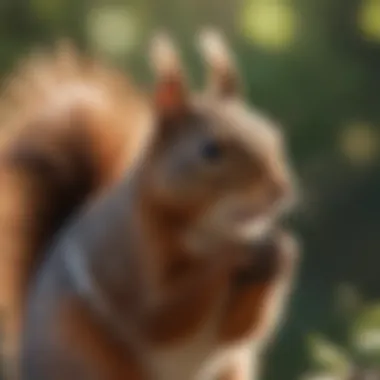
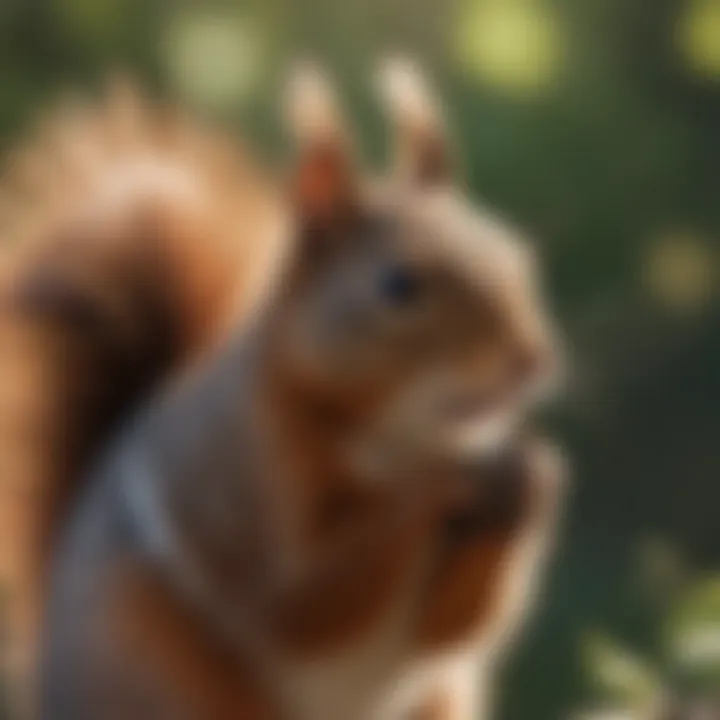
Follow this step-by-step guide for the installation:
- Measure the Height: Use a measuring tape to determine the ideal height for your feeder. A distance of at least five to six feet from the ground is recommended.
- Install Pole or Bracket: If using a pole, secure it firmly in the ground. For brackets, attach them to a tree or wall, ensuring they are stable and straight.
- Attach the Cone Excluder: Position the cone excluder on top of the pole. Ensure it is tight and will not move in the wind. The wider end of the cone should face downwards to maximize effectiveness.
- Mount the Bird Feeder: Place your bird feeder on the cone. Verify that it is secure and that the cone does not obstruct the feeder opening. This step is crucial as it impacts feeding efficiency for birds.
- Test the Setup: Before finishing, check that the feeder is functioning correctly. Observe if the cone allows birds to access feed while preventing squirrels from climbing.
"Proper installation of squirrel cone excluders enhances wildlife management while protecting feed for birds."
Following these steps ensures a successful installation. Paying attention to details can lead to better outcomes in squirrel management.
Effectiveness and Limitations
Evaluating the effectiveness and limitations of squirrel cone excluders is essential for anyone interested in wildlife management, particularly those who wish to protect their bird feeders. These devices aim to maintain a balance between the needs of local wildlife and the desires of homeowners to enjoy birdwatching without interference from squirrels. Understanding the success rates of various designs helps in selecting the right excluder, while recognizing the potential drawbacks allows for informed decision making regarding their use.
Success Rates
The success rates of squirrel cone excluders can vary based on design, installation, and environmental factors. Generally, most models provide a high degree of effectiveness in preventing squirrels from accessing bird feeders. For instance, conical designs that extend far enough below the feeder prove to be the most effective, as they prevent squirrels from climbing up to the feeder's platform.
Studies suggest that these devices can reduce squirrel access by up to 90%. However, this statistic can change based on situational variables. Different types of feeders may require specific designs to maximize success. Another important factor is the material used in the construction of the cone excluder. Metal options tend to outperform plastic ones, as they are generally more durable and less susceptible to wear and tear from outdoor elements.
Potential Drawbacks
While squirrel cone excluders present a promising solution, they are not without limitations. One significant concern is that they do not prevent all forms of animal interference. Birds that are larger or agile can sometimes navigate around these barriers. Moreover, if not installed correctly, excluders can become ineffective. Homeowners must ensure the device is attached securely and aligned properly to maximize its functionality.
Another point to consider is the potential for clutter. Depending on the yard's aesthetics and the arrangement of feeders, cone excluders can be visually unappealing. This may deter some property owners from installing them, despite their benefits. Furthermore, there are specific scenarios where squirrels may adapt their behavior and develop ways to circumvent the devices over time. This adaptability highlights the importance of continuously assessing any animal management strategy.
"No single solution exists for managing wildlife; understanding effectiveness and limitations is key."
Ultimately, while squirrel cone excluders provide a robust tool for managing bird feeder access, homeowners should weigh these pros and cons carefully. A well-informed approach ensures both protection of bird feeds and consideration of local wildlife behavior.
Alternative Solutions to Squirrel Problems
Managing squirrel populations effectively often requires exploring alternatives to conventional methods like squirrel cone excluders. Many homeowners seek solutions that are not only efficient but also environmentally friendly. This section will discuss various strategies that can complement or serve as substitutes for using cone excluders.
Natural Deterrents
Natural deterrents offer a non-invasive approach to keep squirrels away from bird feeders and gardens. They often use non-toxic substances that do not harm the environment or other wildlife. Here are some common natural deterrents:
- Spicy Substances: Applying cayenne pepper or other spicy powders on bird feed can deter squirrels, as they dislike strong flavors. This method is safe for birds but may require frequent reapplication after rain.
- Essential Oils: Oils like peppermint or citrus can be effective in repelling squirrels. When diluted with water and sprayed around feeding areas, they produce odors that squirrels avoid.
- Plants: Certain plants, such as marigolds or mint, can act as natural deterrents. Planting these around garden edges or in mixed flower beds creates barriers that squirrels are likely to avoid.
These solutions are typically safer and often less expensive than mechanical barriers.
Physical Barriers
Physical barriers can provide a more direct method for protecting your bird feeders and gardens from squirrels. They prevent access to food sources while preserving the integrity of your yard. Consider the following types of physical barriers:
- Baffles: Installing baffles on poles supporting bird feeders can obstruct squirrels from climbing up. These rounded shields prevent them from gaining a foothold, effectively rendering the feeders inaccessible.
- Cages: Bird feeder cages allow birds to access feed while blocking larger animals like squirrels. These cages vary in size and can be placed over feeders for maximum protection.
- Fencing: Setting up a fence around gardens can keep squirrels and other pests at bay. A fence should be at least 3 feet tall, and burying part of it underground can deter squirrels from digging underneath.
Each physical barrier method may require some initial investment and installation effort but can lead to long-lasting results.
Important Note: While these solutions may deter squirrels, they may also impact other wildlife. It is crucial to monitor which animals are able to access food sources and adjust methods accordingly.
By implementing these alternative solutions, homeowners can effectively reduce squirrel interference while also promoting a diverse and healthy wildlife ecosystem.
Environmental Considerations
The environmental considerations regarding the use of squirrel cone excluders are vital. These devices are not only tools for managing wildlife but also contribute to broader ecological impacts. Understanding these effects can help users make more informed choices in their efforts to protect bird feeders without causing harm to the surrounding ecosystem.
Impact on Local Wildlife
Squirrel cone excluders primarily prevent squirrels from accessing bird feeders. While they are effective in reducing squirrel interference, it's crucial to examine how their use impacts local wildlife. Not all squirrels pose a threat to other birds. In addition, these devices can inadvertently affect non-target species that might also seek food at feeders. For some local bird populations, restrictive excluders could limit access to food sources altogether.
Research indicates that a balanced approach to wildlife management is essential. People's attraction to backyard birdwatching is often linked with promoting diverse wildlife interactions. Therefore, it is prudent to consider designs of cone excluders that allow smaller birds to access the feeder while keeping larger squirrels at bay. Encouraging a variety of species can lead to healthier ecosystems and enhance overall biodiversity in residential areas.
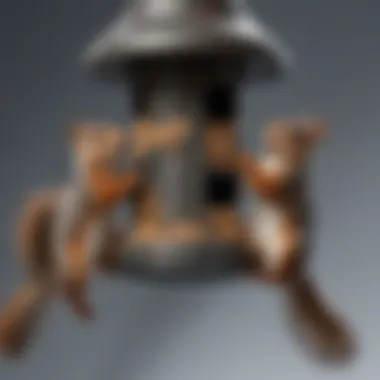

Sustainable Practices
Adopting sustainable practices in the installation and use of squirrel cone excluders is beneficial. Homeowners can use eco-friendly materials to ensure that these devices do not contribute to environmental degradation. For instance, instead of plastic, opting for metal or untreated wood can minimize the ecological footprint of this wildlife management tool.
Moreover, regular maintenance of these devices can extend their life cycle, leading to less waste. Proper cleaning ensures they remain effective while preventing the accumulation of harmful substances that could leach into the environment.
A well-maintained squirrel cone excluder not only protects feeders but also supports local wildlife sustainability efforts.
Finally, community engagement in local wildlife conservation initiatives can promote awareness about the proper use of these devices. By participating in discussion groups or forums on platforms like Reddit, homeowners can share their experiences and learn from others. Collaborative efforts can lead to better solutions that consider the needs of both birds and squirrels, ensuring a more sustainable coexistence.
User Experiences and Testimonials
User experiences and testimonials about squirrel cone excluders are critical to understanding their effectiveness and practicality. They provide real-life evidence of how these devices perform in various environments. Hearing from actual users helps potential buyers to weigh the pros and cons based on firsthand experiences. This section will delve into case studies and expert opinions that highlight the utility of squirrel cone excluders.
Case Studies
Case studies offer insights into various situations where squirrel cone excluders have been implemented. One notable case involved a suburban family struggling with persistent squirrel activity at their bird feeder. After installing a squirrel cone excluder, they noted a significant reduction in squirrel visits. This led to more birds using the feeder, enhancing their backyard experience. The family reported that the materials used for the excluder were durable and easy to clean, further increasing its usability.
Similarly, another case from a local community garden reported improved bird activity after implementing a series of squirrel cone excluders. Gardeners noticed that their bird population grew, enhancing the ecosystem and helping with pest control naturally. This case showed how effective these devices can be in shared spaces, offering benefits not just to individual homeowners but also to the community as a whole.
Overall, these case studies emphasize that when installed correctly, squirrel cone excluders do fulfill their purpose in deterring squirrels successfully. Users found that the devices allowed them to enjoy birdwatching without the frustration of squirrel interference.
Expert Opinions
Expert opinions shed light on the effectiveness and application of squirrel cone excluders. Most pest management experts agree that these devices can play an essential role in wildlife management. According to Dr. Emily Sanders, a wildlife management specialist, “Squirrel cone excluders reduce negative interactions between squirrels and bird feeders.” This is crucial for those who wish to maintain a harmonious backyard while protecting their bird feed.
Dr. Sanders also pointed out the importance of selecting the right model based on local wildlife. For example, certain designs may work better in areas with larger squirrel populations. It is advisable for users to research different excluders and consider their effectiveness in specific habitats.
Moreover, an article published in a wildlife management journal discussed the balance needed between enjoying nature and managing it responsibly. Experts emphasized that while utilizing squirrel cone excluders emerges as a practical solution, it must align with broader wildlife management practices. Ensuring that the devices do not harm squirrels or other wildlife remains imperative.
In summary, user experiences coupled with expert opinions provide a well-rounded view of squirrel cone excluders. They underscore the advantages of these devices while reminding users about responsible wildlife management.
Regulatory and Ethical Considerations
Regulatory and ethical considerations play a crucial role in the discussion around squirrel cone excluders. These devices, while effective in deterring squirrels, must be used within a framework that respects both wildlife and local laws. Understanding these parameters helps ensure that the management of squirrel populations aligns with best practices for ethical wildlife management and regulatory compliance.
Legal Frameworks
When discussing legal frameworks, it is essential to recognize the specific laws governing wildlife control in different areas. In many regions, laws protect certain wildlife species, including squirrels. Regulations may dictate how and when one can use deterrents like cone excluders. Homeowners should consult local wildlife regulations to confirm that their actions comply with state or federal laws.
Commonly, local jurisdictions may require permits for some wildlife management practices. It is beneficial to check with wildlife agencies or local governments. This can prevent legal issues and promote responsible wildlife management. Furthermore, adhering to regulations protects not only the squirrels but also the integrity of local ecosystems.
Ethics of Wildlife Management
Ethics in wildlife management encompasses the moral responsibilities we hold toward other species and the environment. In the context of squirrel cone excluders, it is important to consider the balance between protecting one's interests—such as maintaining bird feeders—and ensuring the welfare of wildlife.
Using squirrel cone excluders aligns with ethical principles of coexistence. Instead of harmful methods, these devices offer a non-lethal way to manage squirrel populations. They prevent access to food sources for squirrels while allowing them to exist peacefully in their habitat.
"Responsible wildlife management promotes harmony between humans and nature."
Moreover, engaging in ethical wildlife management includes educating oneself about local wildlife behavior and the impacts of different management techniques. By selecting humane alternatives like cone excluders, homeowners contribute positively to the ecosystem. This choice reflects a commitment to ethical standards in wildlife interaction and management practices.
In summary, understanding regulatory and ethical considerations is essential for effective and responsible use of squirrel cone excluders. Homeowners and enthusiasts alike must navigate these complexities to foster a cooperative relationship with nature.
Epilogue
The discussion around squirrel cone excluders is vital in the context of modern wildlife management. These devices serve not only to keep squirrels away from bird feeders but also to promote a balanced ecosystem in residential areas. As the article outlines, cone excluders directly address common issues faced by homeowners while also safeguarding the natural habitats of various bird species.
Summary of Key Points
In summary, several important aspects emerge from the exploration of squirrel cone excluders:
- Effective Barrier: Cone excluders effectively deter squirrels from accessing bird feeders, thereby protecting the feed intended for birds.
- Wildlife Harmony: By reducing competition for food, these devices foster a harmonious relationship between humans and wildlife.
- Ease of Installation: Most cone excluder devices require minimal effort to set up, making them accessible solutions for many homeowners.
- Awareness of Limitations: Understanding what cone excluders can and cannot do helps users set realistic expectations.
Future of Squirrel Management
Going forward, the future of squirrel management is likely to see a blend of innovative solutions and ecological awareness. As urban developments expand, conflicts between wildlife and humans might increase. This situation necessitates a deeper focus on sustainable practices that do not harm wildlife. Enhancements in cone excluder designs might emerge, such as materials that are more resistant to wear and tear while remaining effective over time. Additionally, community awareness programs can play a crucial role in educating homeowners on how to deal with squirrel problems responsibly.
In combing through the various elements surrounding the use of squirrel cone excluders, one can conclude that these devices are crucial not only for protecting bird feed but also for promoting a respectful coexistence with nature.



